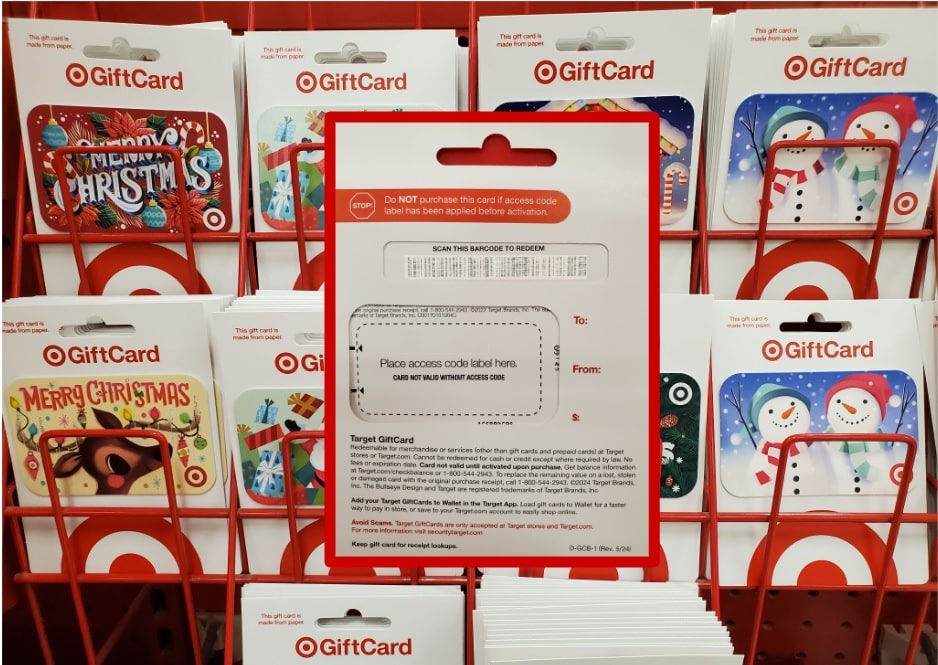
The money you spent on that Target gift card you once bought for your mail carrier, your kids’ teacher or your niece or nephew may have ended up in the pockets of a Chinese money-laundering cartel. So Target is taking action to make sure the only ones who can benefit from its gift cards are their intended recipients.
Just in time for the holiday gift-giving season, Target has redesigned its gift cards with new security features. Before, scammers could steal or alter a card’s access code off its reverse side and hijack the card’s balance after a shopper purchased it. Now, those access codes are behind the counter – the new cards feature a blank space, where a cashier will apply a sticker with the access code once the card is purchased. Without those codes stuck to the gift cards, there will be nothing for a scammer to steal.
The new cards have been rolling out in stores over the past several weeks. Their redesign comes as Target gift cards have become a favorite among criminals in recent years. During last year’s holiday season, police in Fairfax County, Virginia arrested two men inside a local Target who they say were “stocking the shelves with gift cards” that had been altered and returned for unsuspecting shoppers to buy. The men were later found to be in possession of nearly 1,000 gift cards. Weeks earlier, investigators in Sacramento, California arrested a man who was “acting suspiciously near the gift cards” inside a Target store. They later reported finding more than 5,000 stolen Target and Apple gift cards in his possession. And several months earlier, the Alachua County Sheriff’s Office in Florida arrested a man and woman for allegedly stealing more than 1,700 gift cards from local Target stores.
That arrest report cited Target’s corporate office as saying the retailer has lost about $300 million to gift card fraud over the years. Typically, suspects are engaged in “stealing inactivated gift cards from Target stores,” investigators quoted a Target representative as explaining. “The gift cards are then shipped to another location where their information is compromised and cataloged. The cards are then counterfeited/altered, before being shipped back out to another team of threat actors. These individuals then engage in placing the compromised and counterfeited/forged gift cards onto store shelves.”
Sometimes, the silver scratch-off strip on the back of a typical gift card that reveals the security code is carefully removed, the code copied down and the scratch-off strip replaced. So when a gift card is purchased and activated, thieves can use the code to quickly drain the card of its value before the purchaser can.
Other methods are more complex. Earlier this year, a Homeland Security official explained to U.S. lawmakers about how this more elaborate type of scam typically works. First, gift cards are stolen from stores to be “altered,” Ricardo Mayoral, Assistant Director for Countering Transnational Organized Crime at the Department of Homeland Security, said at a Senate hearing. “During the alteration process, the gift card barcodes are replaced by barcodes” controlled by criminal organizations, then returned to store shelves. “When an unwitting customer loads funds onto the altered gift card,” the money goes directly to the criminal organization, which then “converts those funds to hard goods.”
And many of these criminals are associated with Chinese money-laundering organizations, Homeland Security officials say. Earlier this year, Homeland Security Investigations launched “Project Red Hook” in order to “raise awareness of how Chinese organized crime groups are exploiting gift cards to launder money.”
Each of the suspects arrested in Virginia, California and Florida last year were Chinese nationals. According to the Florida arrest report, one of the suspects there “knowingly and willingly was employed in the criminal enterprise of organized gift card fraud perpetrated by a nationwide group of Chinese individuals, targeting Target stores.”
Target is far from criminals’ only victim. Last year, in a survey conducted by the National Retail Federation, 57% of retailers said they had experienced an increase in gift card scams. Unsuspecting shoppers who end up with gift cards devoid of value can typically call the retailer to have that value restored, which means the retailers end up footing the bill for the crimes. And we all may end up paying, in the form of higher prices.
“Gift card draining techniques not only affect retailers, but also our nation’s economy and jeopardize our nation’s national security and public safety,” Homeland Security explains.
But now, Target hopes its new gift cards will ensure that only Target shoppers – and not Target scammers – will benefit. “This should finally end the gift card stealing scams that have been rampant for years,” a Target employee wrote on an online message board. “By making it so the access code is not tied to a gift card number ahead of time, the scammers should have no way to steal gift cards anymore.” Another found it “sad that it has to come to this,” but believed “this will definitely deter the scammers.”
Of course, those behind Project Red Hook warn that “fraudsters adapt quickly and need to be stopped through consistent collaboration with law enforcement.” So Target’s gift card solution is the latest effort to thwart thieves, but it may not be the last. For now, though, fraudsters hoping for a lucrative holiday season will need to look elsewhere – and Target gift card givers can rest assured that their holiday gift won’t amount to an empty gesture.









